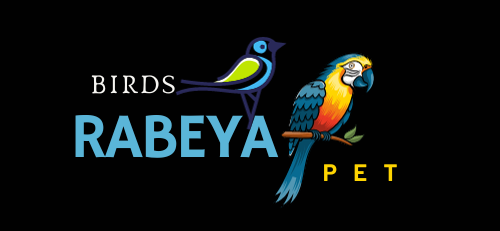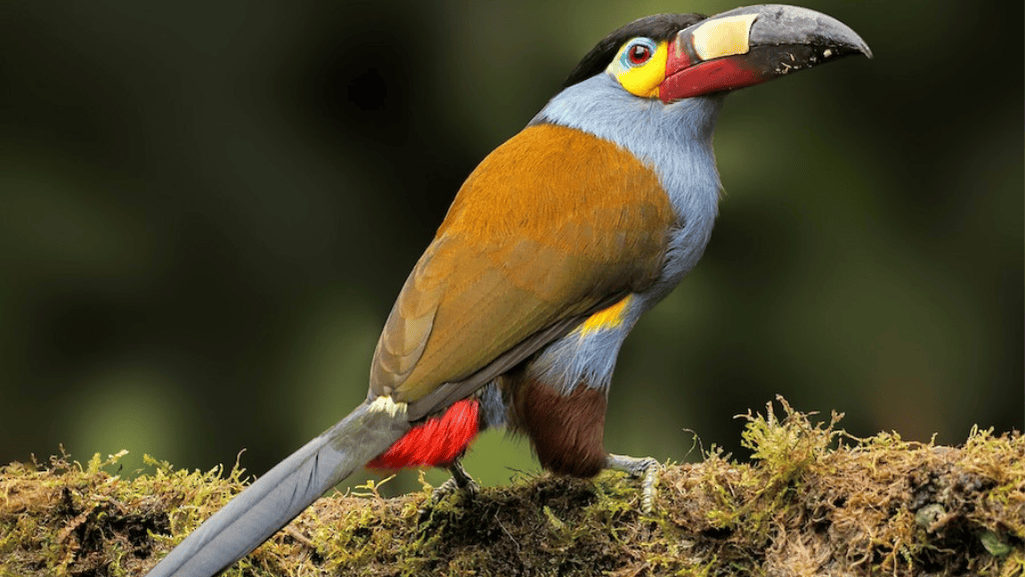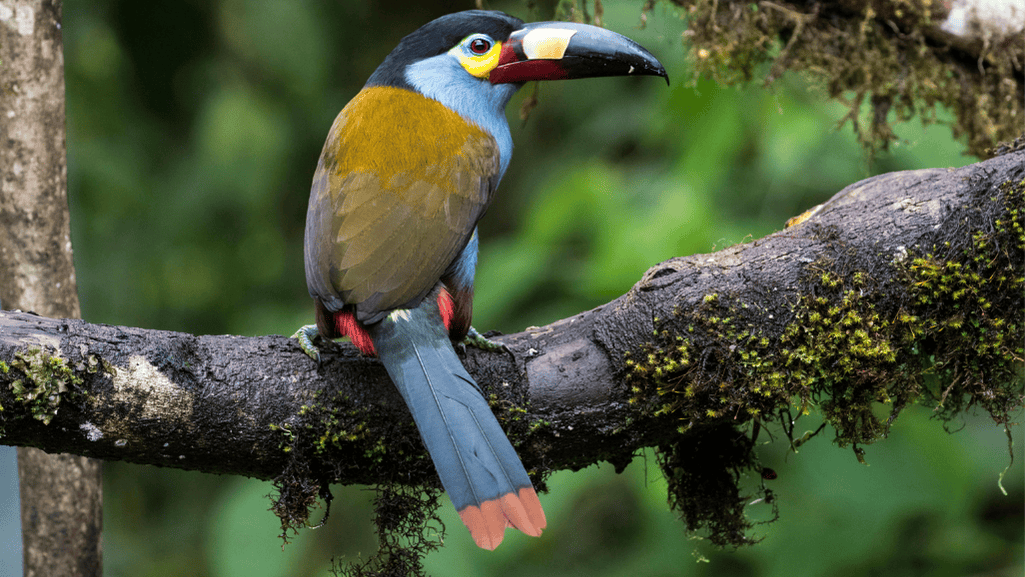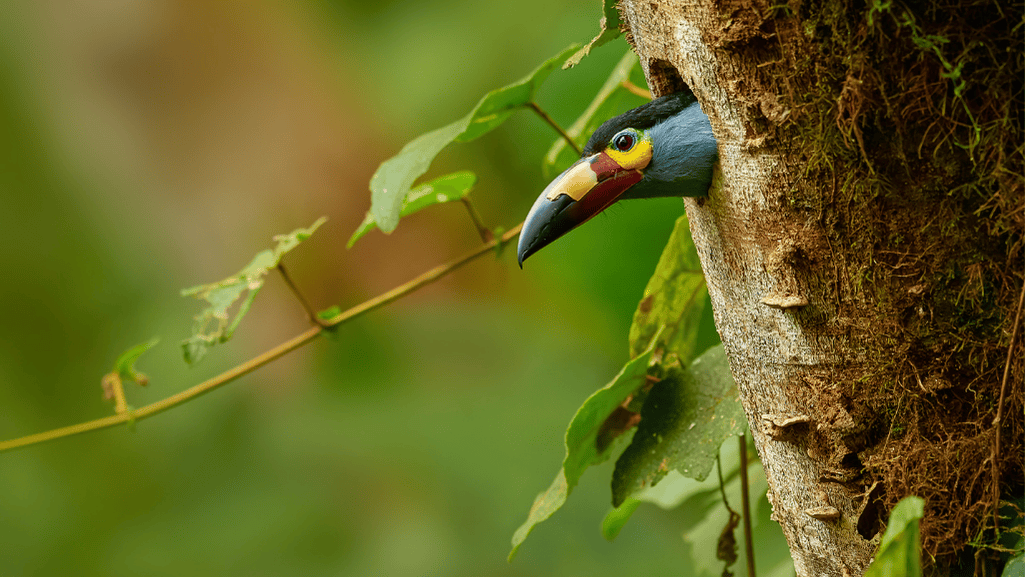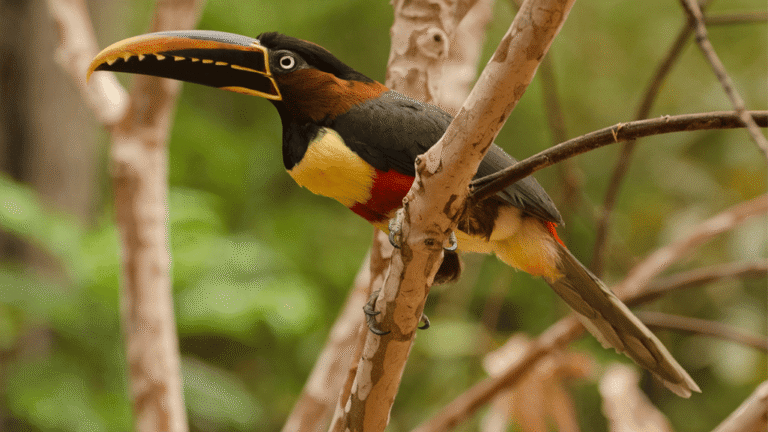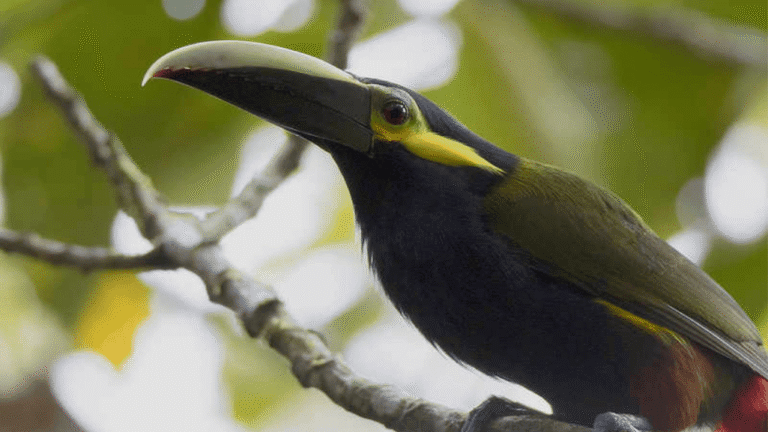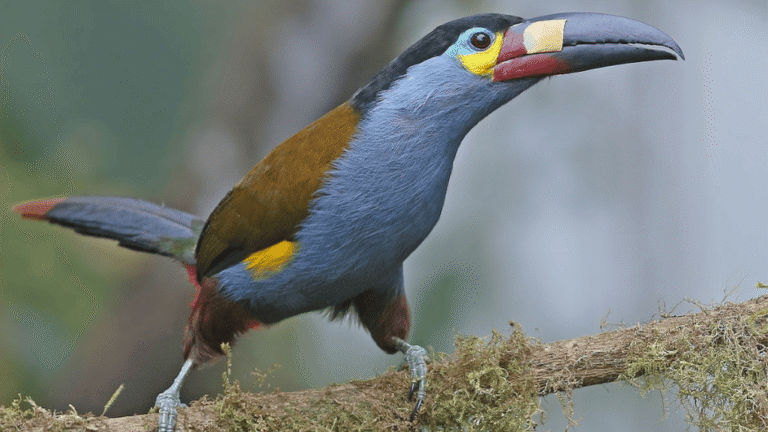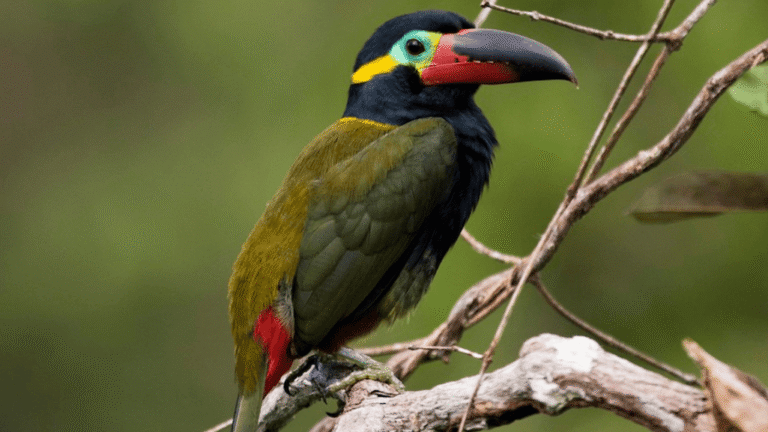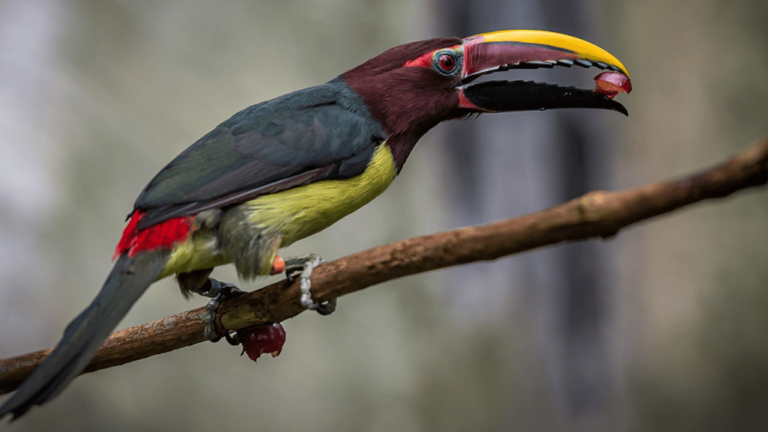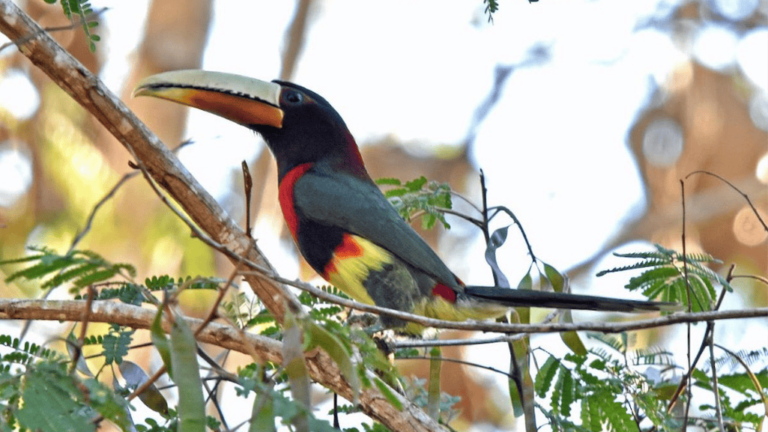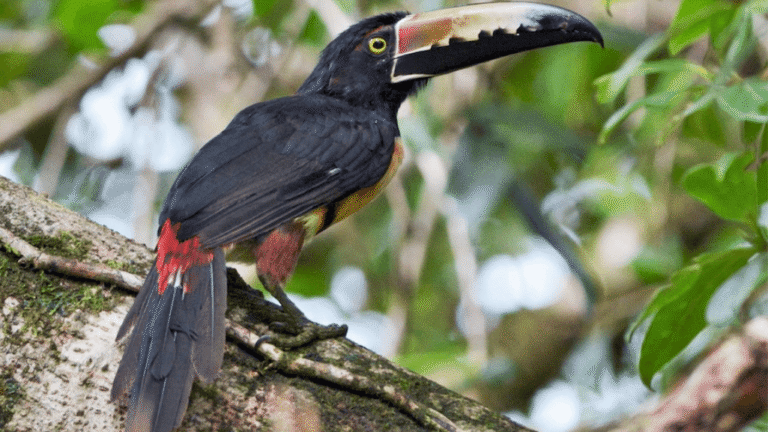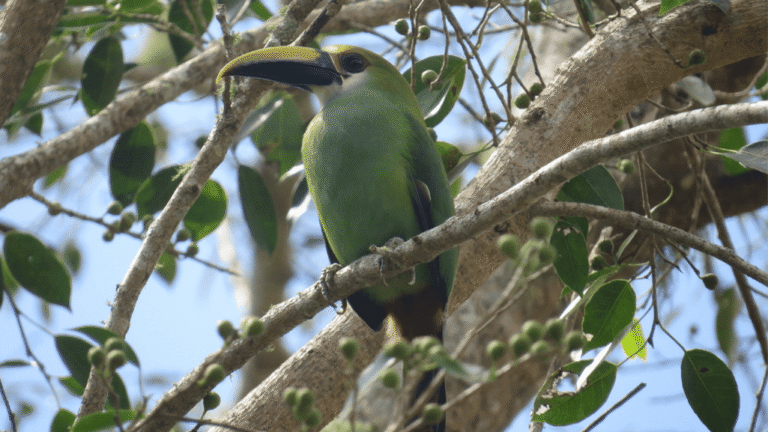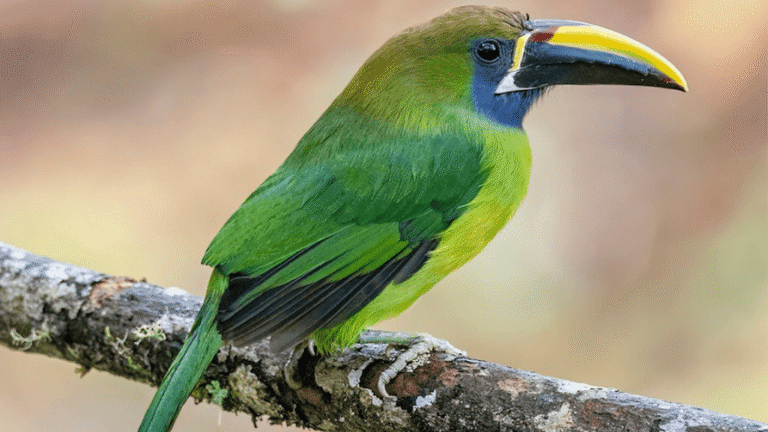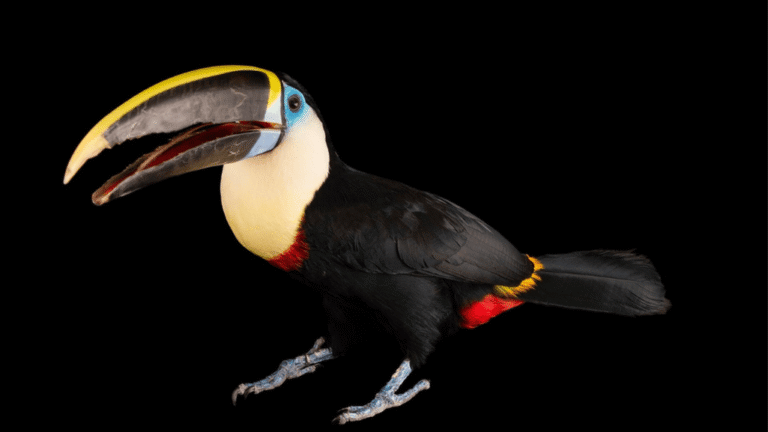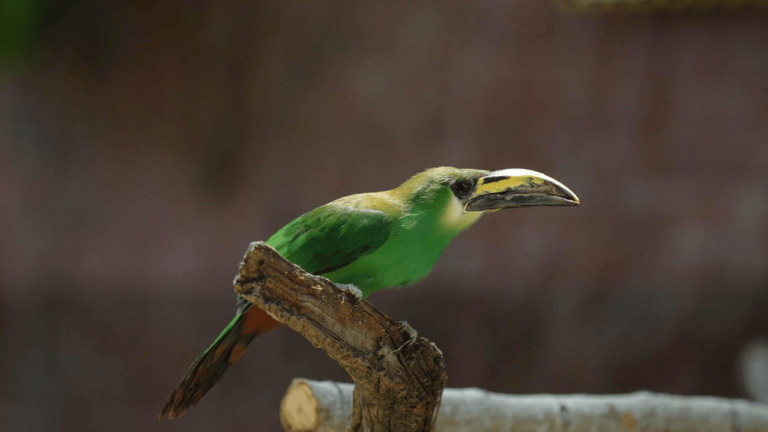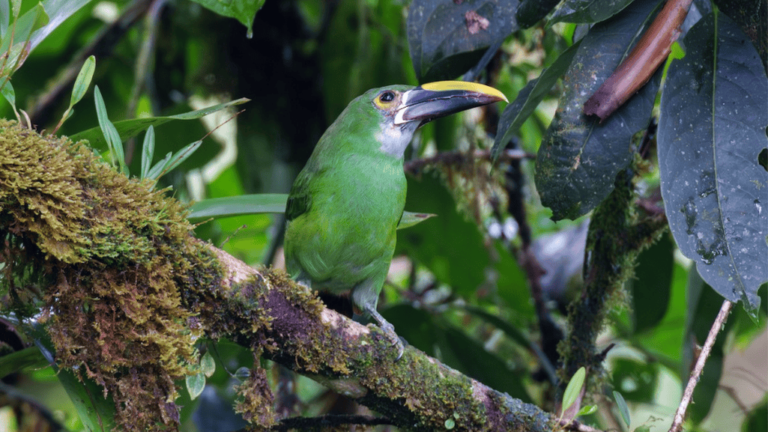The Plate billed Mountain Toucan Andigena , scientifically known as Andigena laminirostris, is a captivating bird species that calls the high-altitude humid mountain forests of the Andes its home. Also referred to as the Plate-billed Toucan or Mountain Toucan, this unique bird belongs to the Andigena genus and is part of the Andigena species group.
Known for its distinctive features, the Plate-billed Mountain Toucan boasts a large laterally compressed bill that sets it apart from other toucan species. The front half of its bill is black, while the back half is a striking shade of red. Additionally, the bird sports a raised yellow plate on its upper mandible, which adds to its visual appeal. Its reddish-brown iris, black crown and nape, and bronzy olive upper parts make it a true sight to behold.
Measuring between 42 to 53 centimeters in length and weighing an average of 303 to 314 grams, the Plate-billed Mountain Toucan is a medium-sized bird. It possesses zygodactylous toes, with two toes facing forward and two pointing back, enabling it to maneuver and grip branches with ease.
This vocal species exhibits distinct vocalizations. The male Plate-billed Mountain Toucan produces a repeating “tryyyyyyyk” sound, while the female emits a drier “t’t’t’t’t’t’t” noise. Its habitat primarily consists of high-altitude montane forests, ranging from 1600 to 2600 meters above sea level, in northwestern Ecuador and extreme southern Colombia.
Key Takeaways:
- The Plate-billed Mountain Toucan (Andigena laminirostris) is a bird species native to the high-altitude humid mountain forests of the Andes.
- Its unique features include a large laterally compressed bill with a black front half and red back half, as well as a raised yellow plate on the upper mandible.
- The bird measures about 42 to 53 centimeters in length and weighs between 303 to 314 grams on average.
- The Plate-billed Mountain Toucan resides in high-altitude montane forests in northwestern Ecuador and extreme southern Colombia.
- It possesses zygodactylous toes, with two toes facing forward and two pointing back.
Description and Plumage
The Plate-billed Mountain Toucan boasts a remarkable and vibrant plumage that captivates the eye. Its upperparts and wings are adorned with a mesmerizing golden olive hue, while the underparts shimmer in a brilliant shade of blue. The crown and neck showcase a glossy black color, beautifully complemented by patches of yellowish green on the face. To add to its allure, the bird’s irises are a striking and vivid shade of red.
One of the most distinguishing features of the Plate-billed Mountain Toucan is its large bill. Not only is it visually striking, but it also serves important functions in the bird’s everyday life. The lower portion of the bill exhibits a deep red color, while the base of the upper bill appears ivory. The rest of the bill is a sleek and sophisticated black, adding depth to its impressive presence. With its large and lightweight bill, the Plate-billed Mountain Toucan possesses the perfect tool for foraging and consuming its favorite meals.
| Plumage Colors | Bill Colors | Additional Features |
|---|---|---|
| Upperparts and Wings: Golden olive | Lower Half: Dark Red | Zygodactyl Toes: Helps with gripping and maneuvering branches |
| Underparts: Bright Blue | Base of Upper Bill: Ivory | Lower Portion of Back (Rump): Yellow |
| Crown and Neck: Glossy Black | Rest of the Bill: Black | Thighs: Reddish-brown |
The Plate-billed Mountain Toucan also possesses zygodactyl toes, which further enhance its adaptability in its natural habitat. With two toes facing forward and two pointing back, the bird is equipped to grip and move effortlessly along branches as it navigates its lush surroundings.
plate billed mountain toucan andigena
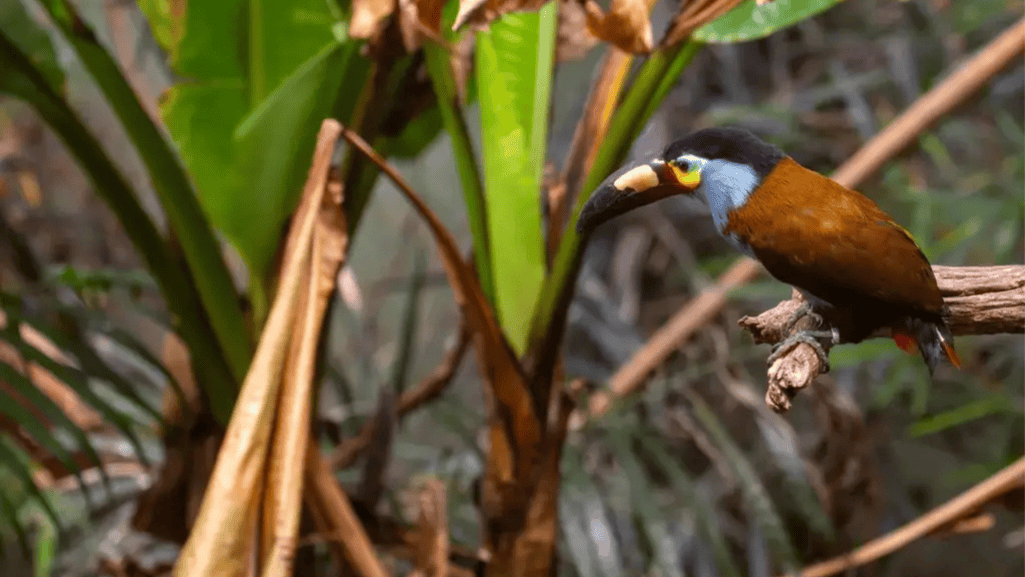 The Plate-billed Mountain Toucan is primarily found in the western foothills of the Andes, specifically in the regions of western Ecuador and southwestern Colombia. This beautiful bird inhabits the high-altitude forests of these areas, thriving in the humid montane forests and along forest edges.
The Plate-billed Mountain Toucan is primarily found in the western foothills of the Andes, specifically in the regions of western Ecuador and southwestern Colombia. This beautiful bird inhabits the high-altitude forests of these areas, thriving in the humid montane forests and along forest edges.
The habitat of the Plate-billed Mountain Toucan is characterized by an abundance of epiphytes, including bromeliads and mosses. With an average annual rainfall of 14 feet, these high-altitude forests provide a lush and diverse environment for the bird. The canopy height ranges from 6 to 10 meters, offering ample tree cover for shelter and foraging.
The altitudinal range of the Plate-billed Mountain Toucan is between 1600 and 2600 meters above sea level. However, there have been observations of this species at higher elevations of up to 3100 meters in Imbabura, Ecuador.
It is worth noting that the Plate-billed Mountain Toucan shares its altitudinal range with another iconic bird species, the Andean cock-of-the-rock. These two species occupy similar ecological niches within the high-altitude forests of the Andes Mountains.
Behavior and Vocalizations
The behavior and vocalizations of the Plate-billed Mountain Toucan are fascinating aspects of this bird’s life. Known for its social behavior, the toucan often roosts in pairs, families, or small groups within its territory. It displays a cooperative foraging behavior, where individuals gather and feed on fruit-rich trees together.
This species is particularly noteworthy for its vocalizations. Among the mountain toucans, the Plate-billed Mountain Toucan stands out as the most vocal. It engages in duetting, a behavior where males and females produce distinct calls that complement each other harmoniously.
The male Plate-billed Mountain Toucan emits a loud and repeating “tryyyyyyyk” sound, while the female produces a drier and staccato-like “t’t’t’t’t’t’t” noise. Both calls can be heard over long distances – the male’s call acts as a territorial proclamation, while the female’s call serves as a response to the male or as a contact call between individuals.
In addition to these vocalizations, the bird also utters rattles and clicks that are loud enough to resonate over a kilometer away. These unique sounds play a significant role in communication and maintaining social bonds within the group.
Fruit Feeding:
The Plate-billed Mountain Toucan has a primarily frugivorous diet, relying heavily on fruit for sustenance. It plays a vital role in seed dispersal for various plant species, contributing to the ecological health of its habitat.
| Plant Species | Role in Seed Dispersal |
|---|---|
| Mountain understory shrub Faramea affinis | Assists in seed dispersal by consuming the fruit and excreting the seeds in different locations. |
| Palm Prestoea acuminata | Contributes to seed distribution by feeding on the palm’s fruits and dispersing the seeds after digestion. |
The Features of Plate-billed Mountain Toucan Behavior and Vocalizations:
- Roosting in pairs, families, or small groups within territories
- Cooperative foraging in fruit-rich trees
- Engaging in duetting with distinct vocalizations
- Males producing loud “tryyyyyyyk” calls and females emitting drier “t’t’t’t’t’t’t” noises
- Uttering rattles and clicks to communicate within the group
- Primarily feeding on fruit, playing a role in seed dispersal for various plant species
Breeding and Reproduction
The Plate-billed Mountain Toucan engages in breeding and reproduction during its designated season, which spans from March to October. The peak period for breeding occurs between May and August. During this time, the toucans build their nests in tree cavities, positioning them at heights of up to 30 meters above the ground.
Each clutch typically contains 2 or 3 white eggs, which are diligently incubated by both parents. The incubation period lasts for approximately 16 days, during which the parents take turns keeping the eggs warm and protected.
After the eggs hatch, the young toucans remain in the nest for an average of 46 to 60 days. This prolonged period allows the fledglings to gain strength and develop the necessary skills for survival. Once they are ready, the juveniles take their first flight and fledge from the nest, marking the beginning of their independent journeys in the forest.
It is worth noting that some toucan pairs may rear a second brood after the successful fledging of their first round of offspring. This further contributes to the perpetuation of the Plate-billed Mountain Toucan population.
Summary
The breeding and reproduction process of Plate-billed Mountain Toucans is a fascinating natural event that takes place within the specified breeding season. From nest-building to incubation, fledging, and potentially rearing a second brood, these birds showcase remarkable parental care and adaptability. These processes play a crucial role in ensuring the survival and continuation of this unique toucan species.
Conservation Status and Threats
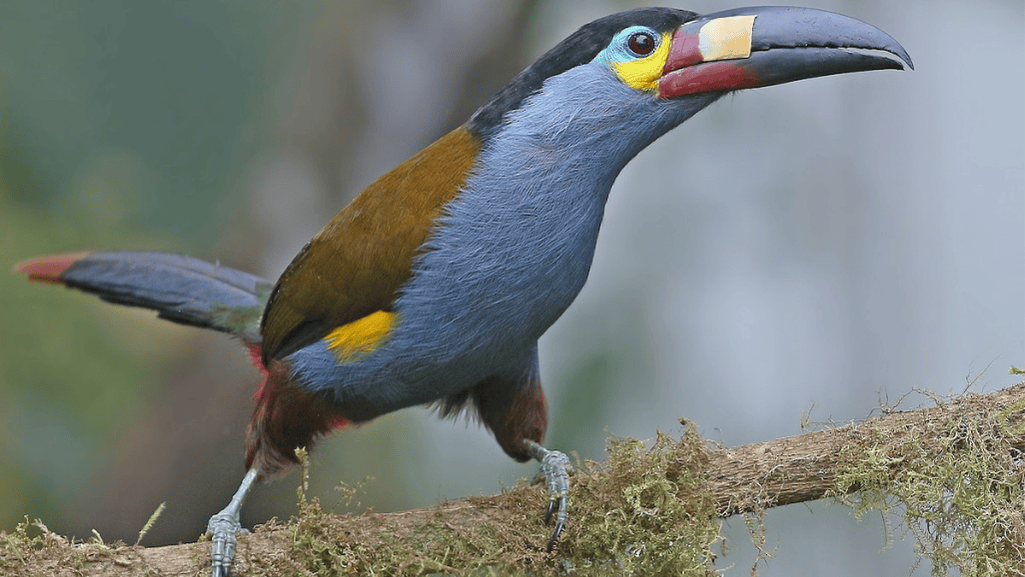 The Plate-billed Mountain Toucan is classified as Near Threatened on the IUCN Red List due to several factors. This species is experiencing habitat loss and fragmentation as a result of deforestation, particularly for agricultural purposes. The bird’s high-altitude forest habitat is being converted into farmland, which negatively affects its population. In addition to habitat loss, the Plate-billed Mountain Toucan is also impacted by illegal trade as it is sought after as an exotic bird.
The Plate-billed Mountain Toucan is classified as Near Threatened on the IUCN Red List due to several factors. This species is experiencing habitat loss and fragmentation as a result of deforestation, particularly for agricultural purposes. The bird’s high-altitude forest habitat is being converted into farmland, which negatively affects its population. In addition to habitat loss, the Plate-billed Mountain Toucan is also impacted by illegal trade as it is sought after as an exotic bird.
Conservation efforts are in place to protect this species, and it is considered the flagship bird of the La Planada Nature Reserve in Colombia.
| Threats to Plate-billed Mountain Toucan | Conservation Efforts |
|---|---|
| 1. Habitat loss and fragmentation due to deforestation | – Establishment of protected areas – Reforestation initiatives |
| 2. Illegal trade for the exotic bird market | – Improvement of law enforcement to combat wildlife trafficking – Public awareness campaigns on the importance of protecting the species |
Conclusion
In conclusion, the Plate-billed Mountain Toucan (Andigena laminirostris) is a captivating bird species that inhabits the high-altitude forests of the Andes in Ecuador and Colombia. Known for its unique features, including its striking plumage, large bill, and zygodactyl toes, this toucan is a sight to behold in its natural habitat.
However, the Plate-billed Mountain Toucan faces significant threats to its survival. Habitat loss, primarily due to deforestation for agricultural purposes, poses a significant risk to the species. Additionally, illegal trade targeting this exotic bird further exacerbates the challenges faced by the population.
To protect the Plate-billed Mountain Toucan and ensure its long-term survival, conservation efforts are crucial. Preserving its unique high-altitude forest habitat and implementing measures to combat illegal trade are essential steps. By taking action to safeguard this beautiful bird species, we can contribute to the preservation of biodiversity and the natural wonders of the Andes Mountains.
FAQ
What is the scientific name of the Plate-billed Mountain Toucan?
The scientific name of the Plate-billed Mountain Toucan is Andigena laminirostris.
Where is the Plate-billed Mountain Toucan found?
The Plate-billed Mountain Toucan is found in the high-altitude humid mountain forests of the Andes in northwestern Ecuador and extreme southern Colombia.
What are the unique features of the Plate-billed Mountain Toucan?
The Plate-billed Mountain Toucan has a large laterally compressed bill with a black front half and red back half. It also has a raised yellow plate on the upper mandible.
What is the size of the Plate-billed Mountain Toucan?
The Plate-billed Mountain Toucan measures about 42 to 53 centimeters in length and weighs between 303 to 314 grams on average.
What is the habitat of the Plate-billed Mountain Toucan?
The Plate-billed Mountain Toucan inhabits high-altitude montane forests with an altitudinal range between 1600 and 2600 meters above sea level. It is found in the western foothills of the Andes in Ecuador and Colombia.
What does the Plate-billed Mountain Toucan eat?
The Plate-billed Mountain Toucan primarily feeds on fruit, but it may also eat insects and eggs.
How does the Plate-billed Mountain Toucan breed?
The Plate-billed Mountain Toucan nests in tree cavities located up to 30 meters above the ground. The clutch usually contains 2 or 3 white eggs, and both parents participate in incubating the eggs for about 16 days.
What is the conservation status of the Plate-billed Mountain Toucan?
The Plate-billed Mountain Toucan is classified as Near Threatened on the IUCN Red List due to habitat loss and illegal trade.

